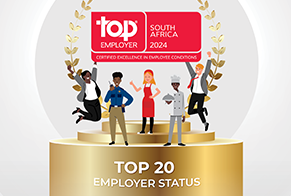Amongst the myriad of issues, any business has to deal with today, employee engagement is a very important outcome and success based indicator. The impact of higher or lower levels of engagement of the workforce can be tremendous, and range in effect from productivity, customer service, innovation, cost management, and ethical behaviour (including fraud and corruption).
What role does the facility/ facilitation manager have to play in helping our Client achieve higher levels of engagement with their people? The modern facilities manager has a distinct advantage together with a depth of skills to leverage the management agenda as well as experience that perhaps no other leader within the organisation has. He or she has the ability to drive workplace decisions towards a workplace that places a priority on wellness and well-being.
In 2016 Tsebo FS Director Andrew Mason gave a presentation at the South African Facilities Management (SAFMA) annual conference, entitled The role of Facilities Management in Employee Engagement the link to the slide deck is at the end of this post.
The evidence speaks loud and clear, that there is a strong and proven connection between workplace well-being, happiness, productivity, performance, customer satisfaction and retention. The value that can be delivered by facilities management will increase as the more innovative companies focus more on the employee experience in its transformation of the workplace. It will require new business skills, innovation and new ways of thinking but this is perhaps why facilities management is the second largest growing professional sector in the UK.
Cinderella Service?
The paradox of facility management has often been that we are only truly successful when our Client doesn’t don’t know we are there. We have been disparagingly referred to as the ‘Cinderella Service’ having spent our careers trying to blend into the background. I believe that under the guidance of the FM our Clients can connect the physical environment with the enterprise strategy thereby not only making the invisible, visible but putting it centre stage and in the spotlight. Facility managers are well placed to understand our Client’s strategy and guide them in a direction that creates an environment to support an engaging management agenda.
More akin to HR than Operations, the FM needs to take a holistic view of the built environment and how it contributes to the users’ experience and the business as a whole. Well-being, productivity, collaboration, engagement and visibility become leadership imperatives and the facility manager holds a central role in creating a place that is vibrant, thriving and alive with potential which will contribute to positive business outcomes.
To do this, Facilities Managers need to change their focus from matters technical to supporting their client’s management and HR agendas in tackling the growing problem of employee engagement. In today’s blog, I offer two practical ways we can leverage the workplace to assist our Clients in achieving higher levels of employee engagement and, thus, impacting on their organisations by creating better workplace performance.
Employee Engagement Levels are Depressing
There has been a wide number of employee engagement surveys in the last five years as the subject has gained in attention, all with wide-ranging results. However, the Gallup poll in 2014 is probably the most widely read and respected amongst its peers. This report stated that “South Africa’s levels of Employee Engagement were depressing” with only 9% of the respondents noted as being “engaged in the workplace”. for every 1 engaged worker there were 5 actively disengaged workers i.e. those that were most negative about their jobs and liable to spread the negativity to other workers. in fact, they could be seen as actively sabotaging their employers business particularly those that are in frontline jobs such as marketing, sales, operations etc. Whilst the global figures are also poor, we in South Africa fair 30% worse than the global average.
Well, I have some good news, in another report by the office furniture manufacturer Steelcase entitled “Engagement & the Global Workplace”, rather than languishing near the bottom of the global league table, South Africa places fourth behind India, Mexico and the UAE for engaged employees.
Whilst both reports share a similar global perspective, showing only a 13 % highly engaged workforce, South Africa scores well with 19% highly engaged employees, 6% above the global average. Only 10% of the 802 South African Steelcase respondents were recorded as highly disengaged as opposed to the 45% in the Gallup survey. This is far above some of our auspicious cousins with the USA only placed sixth and the UK who placed 11th.
What does this tell us, apart from the vagaries of opinion poll results? Well, perhaps as is human nature in these circumstances, we tend to focus at the extremities of the survey. The ability to really affect change, however, lays in those participants in the ‘messy middle’ that are noted to be only slightly or partially disengaged.
As one might surmise, coming from a furniture manufacturer, the Steelcase report offers us more practical suggestions in how to use the workplace as a tool to improve employee engagement. Jim Keane, the CEO of Steelcase, says: “The Steelcase Global Report is the first study that explores the relationship between employee engagement and how people feel about their workplace. Its key findings affirm our belief that the places where people work can influence not only productivity but also shape employee attitudes and beliefs. It demonstrates that the workplace can be part of a holistic strategy to increase engagement”
Steelcase 5 Key Findings
The survey arrived at five key findings, the last one of which our first world cousins may find surprisingly counterintuitive.
Employee Engagement Positively Correlates with Workplace Satisfaction
Workers who are highly satisfied with their workplace demonstrate higher levels of engagement. Highly engaged workers are also more greatly satisfied with various elements of their individual workspace, such as its size, furniture, lighting, ambient noise level and temperature. Thus, indicating that a workplace environment is an important tool for organisations to deploy to improve engagement.
Engaged Employees Have More Control Over Their Experiences at Work
The data shows that those that have a greater degree of control over where and how they work are empowered both by organisational decisions as well as the spaces they working in. This is shown to be key in managing the need for privacy and for concentrated individual work. This leads us to the conclusion that workplaces need to provide a range of spaces for both groups and individuals as well as mobile and resident workers for them to be able to make individual choices about the best ways to work.
Fixed Technology Exceeds Mobile Technology by 2-to-1
In line with the previous item, if the engaged employees need a greater degree of control over where and how they work, access to mobile technology is a significant contributor to employee engagement. The most highly engaged workers are more likely to have laptops, mobile phones and tablets than those that are desk-bound by landline phones and desktop computers.
Traditional Work Styles Persist
The rise of popular culture firms, such as Google and Facebook with their slides and ball pits, have given rise to the perception that the workplace has changed dramatically. This may be true in some places, but around the world, most people still work in traditional office environments with cellular offices and desk-based individual work.
Cultural Context Influences Engagement Levels
Perhaps the most surprising key finding is that the largest concentration of the most satisfied and most engaged workers were in emerging economy nations, where the opportunities are still plentiful. A significant determiner for high levels of engagement were the individual countries, culture, energy and optimistic attitudes. This accounts for the high placing in the study of countries like India, Mexico and South Africa
2 Practical Ways to Improve Employee Engagement
Having come up with these key findings, the Steelcase study goes one step further in indicating how we can turn these into practical workplace strategies to support employee engagement. The report outlines two distinct opportunities.
-
Design for Well-Being
The workplace needs to be designed and operated to support the well-being of its occupants. The broad dimensions of well-being are defined as;
-
Physical – Be healthier
The spaces need to encourage movement throughout the day, to support healthier postures that help people stay comfortable and energised.
-
Cognitive – Think better
The workplace needs to allow the occupants’ spaces for focus and rejuvenation. Individuals need to be able to congregate in teams to think clearly as well as concentrate individually, solving problems and generating new ideas.
-
Emotional – Feel better
Workspaces need to encourage the social nature of work by nurturing a sense of belonging and fostering connections not only between people but also between the organisation and its employees.
-
-
Create an Ecosystem of Different Spaces
Diversity in our workplace, both in terms of the people and the spaces, is critical for success. People need to focus, collaborate, rejuvenate, socialise and learn throughout the day. No single type of space can effectively support the diverse needs of individuals and groups. The workplace needs to be designed as an ecosystem of interconnected spaces and settings where people have choice and control over where and how they work and who they work with. This diversity will help an organisation to be more resilient and use its real estate more effectively and efficiently. The workspace needs to support well-being in the following ways:
-
Posture: Movement and Variety
The workplace needs to encourage regular movement throughout the day and offer options for people to work in sitting, standing or lounging postures.
-
Presence: Digital and Analogue, Physical and Virtual
Spaces should enable quality interactions with teams that are both locally based as well as distributed across continents and time zones.
-
Privacy: Focus and Rejuvenation
The work environment needs to provide places that offer varying ways to achieve privacy both for individual work and for confidential conversations. Privacy is important for all workers and a vital component of both focus and rejuvenation.
The presentation Andrew gave at the 2016 SAFMA Annual conference can be found here The Role of Facilities Management in Employee Engagement
-
Question: How does your workplace maximise the productivity of your staff? Please leave your comments and thought in the space below.



